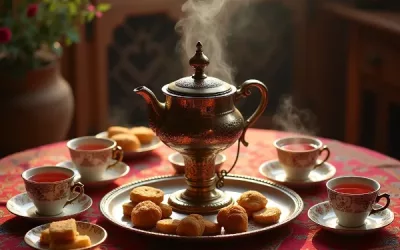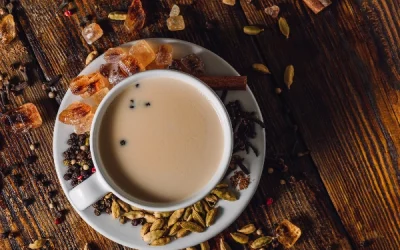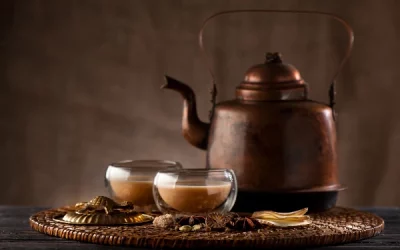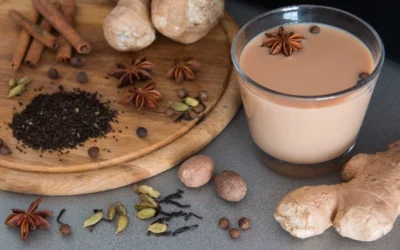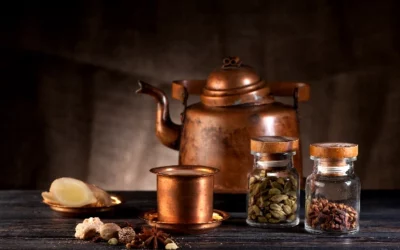Have you ever sipped a cup of Masala Chai and wondered about the rich tapestry of flavours and traditions behind it? This iconic Indian beverage is more than just a drink; it’s a warm embrace that connects cultures and histories. In this guide, we’ll explore the origins, preparation methods, and regional variations of Masala Chai, as well as its cultural significance and health benefits. Discover why this spiced tea has become a beloved staple in homes across the globe and how you can create your own version at home.
Table of Content
- What is the history of Masala Chai Tea?
- How to prepare Masala Chai Tea?
- What are the traditional spices used in Masala Chai?
- What are the different regional variations of Masala Chai?
- What is the cultural significance of Masala Chai?
- What are the health benefits of Masala Chai Tea?
- How can you make masala chai at home?
- Where can you find Masala Chai?
- Conclusion
What is the history of Masala Chai Tea?
Masala Chai Tea, a fragrant and spiced beverage, has deep roots in Indian culture and history. The term “Chai” simply means “tea” in Hindi, while “Masala” pertains to a mix of spices. This rich drink begins its journey in ancient India, where indigenous herbs and spices were frequently used for their medicinal properties.
Historically, Masala Chai was not the tea as we know today. Instead, it was a concoction of spices and herbs without the inclusion of tea leaves. The British colonial influence in the 19th century significantly transformed Masala Chai, combining black tea leaves with spices, milk, and sweeteners, creating the popular beverage we cherish today.
How did Masala Chai originate?
Masala Chai originated in ancient India thousands of years ago. It began as an Ayurvedic concoction:
- Ayurvedic Roots: Ancient Indian healers utilised a blend of local herbs and spices like ginger, cardamom, and clove for their healing properties.
- Medicinal Use: These spice-infused drinks were believed to boost digestion, improve circulation, and enhance overall wellness.
- Original Concoctions: The original recipes likely did not include tea leaves, focusing purely on spices and herbs.
As trade routes expanded, new ingredients were incorporated, eventually including black tea leaves, which marked a significant evolution in the origins of Masala Chai.
What role did British colonialism play in popularising Masala Chai?
British colonialism significantly influenced the popularisation of Masala Chai. The British East India Company began large-scale tea plantations in Assam in the early 19th century:
- Tea Plantations: The British, noticing China’s monopoly on tea, decided to start tea plantations in India.
- Promotional Campaigns: They promoted tea consumption among Indians as part of their strategy to boost tea sales.
- Blending Spices: Locals added native spices to the tea, creating a unique blend that suited their palate.
- Boiling Method: The method of boiling tea leaves with milk and spices became widespread.
British efforts not only introduced black tea to India but also helped in establishing a distinct version of tea that transformed into Masala Chai.
How has the preparation of Masala Chai evolved over time?
The preparation of Masala Chai has experienced several transformations. While the core ingredients remain staple spices mixed with tea, milk, and sweeteners, regional variations and global trends have added diversity:
- Traditional Recipes: Traditional recipes often include black tea, fresh ginger, cardamom, cinnamon, clove, and black pepper.
- Regional Variations: Different regions in India add unique ingredients like star anise, fennel seeds, and nutmeg.
- Modern Twists: Modern versions may include green tea or specialised sugar alternatives like jaggery.
- Western Influence: Adaptations like Chai Latte have become popular in Western countries.
Such evolutions showcase the adaptability of Masala Chai while maintaining its rich historical heritage.
In 1835, the British set up the first commercial tea plantation in Assam. They initially struggled to get locals to drink tea. To increase consumption, they promoted tea breaks in the workplace.
The breakthrough came when Indian vendors, or “chai wallahs,” started adding local spices and other ingredients to make the tea more palatable. This unique mix of ingredients resonated with the locals, establishing Masala Chai as a household favourite.
I remember the first time I drank a cup of Masala Chai. I was visiting a friend’s home in Delhi and her grandmother prepared it the traditional way, using a metal strainer, fresh cardamom pods, and crushed ginger.
The aroma filled the room, and the first sip was a burst of complex flavours. Now, I always make sure to have a packet of fresh spices on hand, ready to recreate that memorable experience.
How to prepare Masala Chai Tea?
If you’re intrigued by the rich, aromatic flavours of Masala Chai Tea, you’re in for a treat! The preparation of Masala Chai involves a careful balance of spices, tea, and milk, creating a deliciously warming beverage that transports you straight to the bustling streets of India. Let’s break down the step-by-step method to prepare this invigorating drink.
To help you navigate the preparation, here’s a detailed table of ingredients, their quantities, and the preparation steps:
| Ingredients | Quantities | Preparation Steps |
|---|---|---|
| Water | 2 cups | Start by boiling water in a saucepan. |
| Black Tea Leaves | 2 teaspoons | Add the tea leaves to the boiling water. |
| Fresh Ginger | 1-inch piece (sliced) | Toss in the sliced ginger for a zesty kick. |
| Cardamom Pods | 4-5 (crushed) | Add the crushed cardamom pods. |
| Cinnamon Stick | 1 small stick | Drop in the cinnamon stick to enhance the aroma. |
| Cloves | 3-4 | Include the cloves for a spicy note. |
| Black Peppercorns | 2-3 | Pop in the peppercorns for a hint of heat. |
| Milk | 1 cup | Pour in the milk once the tea and spices simmer. |
| Sugar or Honey | To taste | Sweeten with sugar or honey as preferred. |
Using this table, you can easily gather your ingredients and follow the preparation steps to craft your perfect cup of Masala Chai Tea.
What are the preparation steps?
To make a delightful cup of Masala Chai Tea, follow these simple steps that blend boiling, simmering, and precise additions of spices and sweeteners.
- Start by boiling 2 cups of water in a medium-sized saucepan.
- Add 2 teaspoons of black tea leaves into the boiling water.
- Incorporate 1-inch sliced fresh ginger to the mix for an invigorating aroma.
- Crush 4-5 cardamom pods and add them to the brewing tea.
- Include 1 small cinnamon stick for a distinct flavour.
- Add 3-4 cloves into the saucepan.
- For a bit of heat, toss in 2-3 black peppercorns.
- Let the mixture simmer for 4-5 minutes, allowing the spices to infuse.
- Pour in 1 cup of milk and bring the mixture to a gentle boil.
- Sweeten the tea with sugar or honey according to your taste preference.
- Simmer for another 2 minutes, then strain the tea into cups and enjoy.
By following these steps, you can ensure that each cup of Masala Chai Tea you make will be rich, aromatic, and perfectly spiced.
What are the unique flavours of Masala Chai Tea?
Masala Chai Tea stands out because of its combination of robust, earthy, and slightly spicy flavours. These diverse ingredients come together to create a harmonious blend.
- Ginger: Adds a sharp and warming flavour.
- Cardamom: Lends a sweet and floral note.
- Cinnamon: Contributes a sweet and woody essence.
- Cloves: Enhance the tea with a warm and pungent taste.
- Peppercorns: Introduce a mild heat.
- Black Tea: Provides a strong base with earthy undertones.
- Milk: Adds creaminess, balancing the spice and sweetness.
These flavours ensure that each sip is a complex experience, stimulating your taste buds.
One day in the 19th century, as Indian railways began to expand, vendors started selling tea made with traditional Indian spices to passengers. This was a time when British colonists introduced tea plantations to India.
They wanted to promote tea drinking, primarily for economic reasons. The chaiwala (tea vendors) added local spices, milk, and sugar to create a more appealing drink for the Indian palate. This blend quickly became popular, leading to the widespread enjoyment of Masala Chai that we see today.
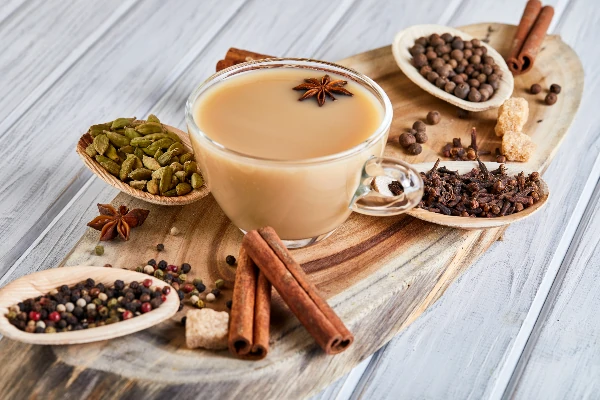
What are the traditional spices used in Masala Chai?
Alright, let’s dive headfirst into the fragrant world of traditional Masala Chai spices. Think of this as a spicy tea parade with colourful floats emblazoned with cinnamon, cardamom, ginger, black pepper, and cloves. These aren’t just any spices; they’re the rockstars of the Masala Chai world, each adding its unique flair to the show.
Cinnamon
Cinnamon is like that charismatic friend who lights up every party. Its warm, sweet notes balance out the tea’s bold flavours, giving Masala Chai its distinctive warmth and depth. Plus, it smells fantastic, which isn’t a bad bonus.
Cardamom
Cardamom is the sophisticated guest with a touch of mystique. Its aromatic, slightly citrusy flavour lifts the tea, adding a zesty edge. A few cardamom pods can transform a simple cup of tea into a sensory experience.
Ginger
Ginger is the energiser bunny of the group. Spicy, robust, and brimming with zing, it adds a powerful kick that wakes up your taste buds. It’s the spice that ensures your Masala Chai packs a punch.
Black Pepper
Black pepper may seem like a surprising addition, but it’s the spice that gives your chai that subtle kick in the back of your throat. It enhances the other spices, making everything taste more vivid and dynamic.
Cloves
Cloves are the secret weapon, adding an earthy depth and a hint of sweetness. They are small but mighty, contributing to the chai’s overall complexity and richness.
Why are these spices used in Masala Chai?
These traditional spices aren’t thrown into the mix just because someone had a whimsical impulse. They each serve a purpose, transforming mundane black tea into something spectacular. Let’s break it down:
- Balance: The interplay of sweet, spicy, earthy, and citrus notes creates a harmonious balance.
- Aroma: The combined fragrance of these spices is like aromatherapy in a cup.
- Tradition: These spices have been used for centuries in Indian households, carrying cultural significance and heritage.
- Versatility: The flexibility of these spices allows home brewers to adapt the recipe to their palate.
Adding these spices to your Masala Chai means you’re participating in an age-old tradition of delicious complexity.
What are the health benefits of these spices?
It’s not just your taste buds that enjoy a dance party with Masala Chai. These spices bring a host of health benefits, so your body appreciates them too.
- Cinnamon: Anti-inflammatory properties, helps regulate blood sugar levels.
- Cardamom: Aids digestion, has antimicrobial properties, and boosts oral health.
- Ginger: Excellent for digestion, anti-nausea, and superb for combating cold symptoms.
- Black Pepper: Enhances nutrient absorption, rich in antioxidants, and has anti-inflammatory effects.
- Cloves: Rich in antioxidants, promotes bone health, and improves liver function.
By sipping on a cup of Masala Chai, you’re not just enjoying a delightful beverage, but also giving your body a little TLC.
How do these spices contribute to the flavour of Masala Chai?
When it comes to flavour, each of these spices plays its part to perfection, contributing to the rich tapestry of Masala Chai.
- Cinnamon: Adds sweetness and warmth.
- Cardamom: Offers a citrusy brightness and floral aroma.
- Ginger: Delivers a sharp, spicy kick.
- Black Pepper: Introduces a subtle heat and deepens the flavour profile.
- Cloves: Imparts a sweet, earthy tone, rounding off the spices with a hint of bitterness.
The result is a tea that’s more than the sum of its parts, offering a complex, satisfying sip every time.
One historical snippet to leave you with: during the British colonial period in the 19th century, tea plantations sprung up across India. Indians put their own spin on the drink by incorporating these deeply ingrained spices. Over time, localised versions evolved, making Masala Chai a national beverage. So, when you sip on this aromatic concoction, you’re sharing a cup with history itself.
What are the different regional variations of Masala Chai?
When it comes to Masala Chai tea, India offers a delightful buffet of regional variations, each with its unique spin on this comforting beverage. Let’s dive into the chai wonderland of North India, South India, West India, East India, and even how Masala Chai has taken on new forms internationally.
Masala Chai in North India is like a warm hug from a spicy grandparent. Rich in strong Assam tea, it’s brewed with a medley of spices like cardamom, cinnamon, cloves, and ginger. Up here, you can’t ignore the chilly winds, which is why they make their chai spicy enough to blow a dragon’s breath—Ginger and black pepper are the usual culprits.
Head down south, and you’ll notice the chai loses some of its spicy aggression and adopts a more laid-back, tropical character. Coconut milk often replaces cow’s milk, offering a creamier texture. And the spices? Expect to find more star anise and nutmeg, which blends in with the coconut milk to create a flavour that’s both fresh and comforting.
In West India, particularly Maharashtra and Gujarat, they don’t mess around. They love their chai strong and sweet, often brewing it with an array of spices that includes fennel and bay leaves. This variation usually comes out thicker, thanks to the generous use of milk.
East India offers something of a cross-cultural melange, often blending traditional Assam tea leaves with local spices and sometimes even including a sprinkle of black tea from neighbouring Darjeeling. The flavour profiles here are more subdued, but no less enjoyable.
And finally, on the international front, Masala Chai has blended (pun intended) into various cultures, making an appearance in cafes and homes from New York to Melbourne. Sometimes, it’s hilariously dubbed as a “Chai Tea Latte,” which is a big no-no in Indian terms (I mean, chai literally means tea). Here, cardamom, cinnamon, and a ton of frothy milk are commonly used, and occasionally you might even find some overly adventurous souls experimenting with vanilla or caramel.
How do regional variations differ in terms of ingredients?
North Indian Masala Chai is heavy on spices like cardamom, cloves, and of course, a generous amount of ginger and black pepper. They love the heat, and boy, do they show it with their masala combos.
- North India:
- Ingredients: Assam tea, ginger, cardamom, cloves, black pepper, cinnamon
- Characteristics: Strong, spicy, robust
- Features: Often used to combat cold weather
In the south, coconut milk takes centre stage, adding that luscious, creamy texture.
- South India:
- Ingredients: Coconut milk, star anise, nutmeg, regular milk
- Characteristics: Creamy, aromatic, soothing
- Features: Tropical flavours from coconut
Western Indians prefer their tea on the sweeter side, incorporating fennel and bay leaves to add an extra punchy dimension.
- West India:
- Ingredients: Fennel, bay leaves, cardamom, saffron
- Characteristics: Sweet, thick, aromatic
- Features: Deep flavour from fennel and bay leaves
Eastern India keeps things subtle but complex, mixing local teas and either slightly fewer spices or more subtle ones to let the tea shine.
- East India:
- Ingredients: Assam tea, Darjeeling tea, green cardamom, cinnamon sticks
- Characteristics: Light, fragrant, soothing
- Features: Balanced between strong Assam and light Darjeeling tea
Worldwide, the international versions keep it simple but might mistakenly mix in vanilla or caramel flavours.
- International Versions:
- Ingredients: Same basic spices but often with additions like vanilla or caramel
- Characteristics: Sweet, frothy, milky
- Features: Adapts to the sweet-tooth culture of the West
What are some unique regional recipes for Masala Chai?
In the northern regions, the quintessential Masala Chai might include jaggery instead of sugar, adding a rustic sweetness.
- Northern Recipe:
- Assam tea
- Jaggery
- Cardamom, black pepper, ginger, and cloves
- Benefits: Adds depth of sweetness with jaggery
Down south, using coconut milk instead of regular milk transforms the chai into a tropical treat.
- Southern Recipe:
- Strong black tea
- Coconut milk
- Star anise, nutmeg, ginger
- Benefits: Rich, creamy texture from coconut milk
Western India’s secret weapon? Saffron and fresh bay leaves make their chai exceptionally fragrant.
- Western Recipe:
- Marathi chai
- Saffron threads
- Fresh bay leaves, fennel seeds
- Benefits: Exudes a royal, luxurious aroma
Eastern India may incorporate Darjeeling tea leaves, creating a milder, more aromatic brew.
- Eastern Recipe:
- Assam tea blended with Darjeeling tea
- Mild spices like little green cardamom, cinnamon sticks
- Benefits: Light and refreshing, a balanced act of two famed teas
Internationally, café versions might use a chai syrup or even pre-mixed powders.
- International Recipe:
- Pre-mixed Chai powder
- Frothy steamed milk
- Optional vanilla or caramel syrup
- Benefits: Easily customisable flavours, albeit less authentic
How do cultural influences affect these regional variations?
Cultural traditions and climate play a huge role in shaping these variations. North’s spicy chai aims to fend off the cold, while the South opts for refreshing, tropical flavours to beat the heat.
- North India:
- Climate: Cold, mountainous
- Cultural Traits: Rich use of traditional spices for warmth
- Social Practices: Chai stalls (known as “chaiwallahs”) that usually serve piping hot, spicy teas
- South India:
- Climate: Tropical, humid
- Cultural Traits: Preference for smooth, coconut-based beverages
- Social Practices: Often paired with light snacks like banana chips
Western India’s sweeter chai reflects their love for elaborate and aromatic foods.
- West India:
- Climate: Mixed, but predominantly hot
- Cultural Traits: Love for rich, sweet flavours
- Social Practices: Frequently enjoyed during social gatherings and festivals
Eastern variations blend local ingredients due to the tea-producing regions and their affinity for finesse in flavour.
- East India:
- Climate: Varied, can be humid
- Cultural Traits: Subtlety in flavours thanks to the quality of local tea
- Social Practices: Preferred during serene, evening chit-chats
International deviations incorporate exotic elements due to the Western penchant for innovation and trying new flavours.
- International Variations:
- Influences: Cafes and tea houses adapting to customer needs
- Cultural Traits: Simpler, sweeter versions aligning with Western taste profiles
- Social Practices: Enjoyed as a trendy alternative to coffee
And just to wrap things up with a historical flavour, did you know that the British Raj played quite a role in popularising tea in India? During their colonial rule, the British introduced tea plantations to India, mainly in Assam, aiming to break China’s monopoly on the tea market.
Initially, tea earned a lukewarm response from the locals, but over time, through clever marketing and the incorporation of local spices, it eventually became the iconic Masala Chai we know and cherish today.
So, next time you sip your masala chai tea, remember, it’s a brew with a colourful past!
What is the cultural significance of Masala Chai?
Masala Chai is not just a beverage; it’s a cultural phenomenon, deeply tied to Indian traditions and society. Created by blending black tea with a variety of spices, this drink offers a sensory experience that’s aromatic and flavourful.
But beyond its taste, Masala Chai has become a symbol of Indian hospitality, an essential element in social gatherings, and a daily ritual for many. It’s also made waves globally, influencing tea culture far beyond the borders of India.
From the way it’s lovingly prepared to how it brings people together, this tea has stories to tell and memories to make. So, grab your cup of Masala Chai and read on.
How is Masala Chai integrated into Indian hospitality?
Ah, Indian hospitality! It’s about making guests feel at home, and nothing says “welcome” like a steaming cup of Masala Chai.
- First Impressions: The moment you step into an Indian home, you’re most likely greeted with a cup of this spicy, aromatic beverage. It’s their way of saying, “Hey, you’re important to us!”
- Golden Rule of Hosting: Offering Chai is more than just a habit; it’s a sacred rule. Denying a guest a cup of tea might as well be a faux pas.
- Handcrafted Delight: Unlike your average tea bag dunking, Masala Chai is a handcrafted affair. The host painstakingly prepares it with fresh spices, ginger, and often a dash of love.
- Warmth and Comfort: It’s the embodiment of warmth and comfort, making it perfect for welcoming someone into your home, especially if they’ve travelled a long distance.
- Universal Language: Whether in a palatial mansion or a humble abode, this tea serves as an equaliser, breaking barriers and creating bonds over its rich, complex flavours.
In India, welcoming someone with Masala Chai is akin to sharing a piece of your heart. It’s not just a drink; it’s a gesture of goodwill and warmth.
Ever been to an Indian social gathering without chai? Exactly, they don’t exist. This tea is more than just a refreshment; it’s a social lubricant.
- Gathering Catalyst: Be it a casual get-together or a formal event, Chai acts as the catalyst that gets conversations flowing.
- Friendship Brewed: Friendships are often forged over a cup of Masala Chai, making it an essential element in social bonding.
- Breaks the Ice: The process of preparing and sharing Chai makes for excellent ice-breaking conversations, especially among people meeting for the first time.
- Religious Festivities: Think festivals like Diwali or Holi; Chai is always there, amplifying the joy and camaraderie of the occasion.
- Not Just for Adults: It transcends generations, with everyone from kids to grandparents partaking in the Chai ritual, thus binding ages together in one unified experience.
In essence, a gathering without Chai would be like a Bollywood movie without dance numbers—just plain wrong!
How has Masala Chai influenced global tea culture?
Masala Chai has gone global, and how! From the street corners of Mumbai to the swanky cafes of New York, this Indian brew has left its spicy mark.
- Café Menus Worldwide: Walk into any cosmopolitan cafe and you’re likely to find “Chai Latte” on the menu. The world has embraced this exotic blend, sometimes with a twist.
- Fusion Madness: Chefs and mixologists are getting creative, incorporating Masala Chai in everything from ice creams to cocktails.
- Cultural Exchange: It has paved the way for a cultural exchange, allowing people to get a taste of India without ever boarding a plane.
- Health Craze: The spices used—cardamom, cinnamon, ginger—are lauded for their health benefits, making Chai a go-to for wellness enthusiasts.
- Merchandising: From pre-packaged Chai blends to Chai-infused beauty products, this beverage has spawned a whole industry.
Masala Chai’s journey from humble Indian origins to global stardom is nothing short of extraordinary.
Back in the 19th century, when the British ruled India, they introduced tea plantations. But Indians, in their resourceful style, made it their own by adding local spices, thus creating Masala Chai. Fast forward to today, and this spiced tea has become a symbol of cross-cultural integration, blending the East and the West in a cup.
So, next time you take a sip of Masala Chai, remember that you’re also taking a gulp of history, tradition, and social evolution. Cheers!
What are the health benefits of Masala Chai Tea?
Ah, Masala Chai Tea, the aromatic elixir that not only jazzes up your taste buds but also amps up your health. You might think it’s just a fancier way to sip on tea, but it’s an undercover superhero for your body.
It’s got a whole squad of spices like ginger, cardamom, cinnamon, cloves, and black pepper, each bringing its own set of benefits. Yup, this spiced brew isn’t just delicious; it’s like a health potion from Harry Potter’s apothecary. Let’s dive into how Masala Chai takes your well-being from blah to voilà.
How does Masala Chai aid in digestion?
So, you’ve wolfed down an entire pizza and now your tummy’s throwing a tantrum. Enter Masala Chai, the digestive hero. The blend of spices isn’t just for taste; it’s got digestives written all over it.
- Ginger: Reduces bloating and gas. Goodbye, food baby!
- Cardamom: Kicks acid reflux to the curb.
- Cinnamon: Keeps those digestive juices flowing.
- Black Pepper: Boosts the digestive enzymes and juices.
When all these guys team up, you get a concoction that keeps your digestive system humming like a well-oiled machine.
What anti-inflammatory properties do the spices in Masala Chai have?
Your body deals with inflammation like a boss, but sometimes it needs backup, especially if you’re guilty of Netflix and crisps. The spices in Masala Chai are like your immune system’s hype squad.
- Ginger: Acts like a bouncer, kicking out inflammation at the cellular level.
- Turmeric: The golden wonder, acts as an anti-inflammatory agent.
- Cloves: These tiny bombs of goodness can reduce pain and swelling.
- Cinnamon: Packs a punch with its anti-inflammatory properties.
The next time you’re feeling a little sore, a cup of Masala Chai can act as a small, but mighty, anti-inflammatory tonic.
How does Masala Chai support the immune system?
No one enjoys being knocked out by the flu or a cold. Masala Chai steps into the ring with your immune system to add some extra muscle.
- Cloves: Rich in antioxidants; they fight off those pesky free radicals.
- Cardamom: Contains vitamin C, boosting your immune defence.
- Cinnamon: Has antibacterial properties to zap germs.
- Ginger: Manages to provide immune support by fighting infections.
A daily dose of this spiced brew is like giving your immune system a personal security detail.
Feel more connected to this cup of chai? Let’s not forget that the habit of drinking Masala Chai traces all the way back to the ancient courts of the Siamese Kingdom. Royalty often drank this brew not just as a morning cup but as a medicinal potion. It was believed to be an all-encompassing health beverage, rightfully fitting for kings and queens. So, when you sip on your Masala Chai Tea, remember you’re indulging in a regal, time-tested ritual that’s been boosting health for centuries. Cheers to that!
How can you make masala chai at home?
Making masala chai at home is like orchestrating your own flavour symphony. It’s about balancing the spices, sweetness, and robustness to create the perfect cup of warmth and comfort. Think of it as a delicious chemistry experiment, minus the lab coat, with the marvellous addition of flavour explosions.
It’s not rocket science – although, if you get it right, it might feel like you’ve achieved something just as impressive. You need the right ingredients, the right method, and the right Ayurvedic attitude. Let’s get into the nitty-gritty.
What are the essential ingredients for making masala chai at home?
Your masala chai adventure starts with gathering the right battalion of ingredients. You don’t need a thousand spices – just the right few that pack a punch. Here’s what you need:
- Loose black tea leaves or tea bags: Choose robust varieties such as Assam or Darjeeling.
- Whole milk: For that creamy goodness, but go nuts with plant-based milk if that’s more your style.
- Water: Plain old H2O.
- Sweetener: Sugar is traditional, but honey, jaggery, or agave nectar work too.
- Ginger: Freshly grated for that zing.
- Cardamom pods: Slightly crushed for fragrance.
- Cloves: Whole, not ground.
- Cinnamon stick: Adds warmth.
- Black peppercorns: A kick of heat.
- Fennel seeds: (Optional) A sweet twist.
By now, you’ve probably Instagrammed your ingredients, feeling like a true chai connoisseur. Let’s move on to turning these humble components into a steamy cup of joy.
How can you adjust the spice levels to suit your taste?
Adjusting the spice levels in your masala chai is a bit like playing Goldilocks with your taste buds. Not too spicy, not too bland – you need it just right.
- Start mild: If you’re new to the game, go easy on the spices. Use smaller amounts and taste as you go.
- Tailor to taste: Increase spices like ginger and black pepper if you want more heat. Reduce them if you prefer a gentler brew.
- Dry roast: Try dry roasting your spices before brewing to intensify their flavour. But warning – your kitchen will smell like a spice bazaar.
- Blend and test: Experiment with different combinations and amounts of spices. Note down your favourites and adjust accordingly.
- Balance with sweeteners: Adding more sugar or honey can balance out a spicer brew.
Once you’ve nailed your personal masala chai spice mix, you’ll feel like nothing’s gonna spice up your life quite the same way again!
What are some serving suggestions for Masala Chai?
Serving masala chai is not just about pouring it into a cup – it’s about creating an experience. Here’s how to up your chai game:
- Traditional cups: Use small, handle-less terracotta cups, known as ‘kulhars’, if you want an authentic feel.
- Accompaniments: Serve with snacks like samosas, pakoras, or biscuits to dunk.
- Chilled version: For a twist, chill your masala chai and serve it over ice – a refreshing take on a classic.
- Chai latte: Froth some milk and pour it over your brewed tea for a café-style chai latte.
- Garnish: Add a cinnamon stick or a sprinkle of nutmeg on top for extra pizzazz.
These suggestions can make even the simplest cup of masala chai feel like a five-star experience. And isn’t life too short for anything less?
Back in the day, a cool cat named Emperor Shen Nong supposedly discovered tea when some leaves accidentally blew into his pot of boiling water. Curious, he took a sip and voila – the world found a new obsession. And if an imperial brew can come out of a happy accident, imagine what you can do with a pinch of precision and a dash of creativity.
Where can you find Masala Chai?
So, you’ve caught the Masala Chai bug and you’re not sure where to grab a cuppa? Well, you’ve come to the right place. This spicy, invigorating beverage can be found in a variety of spots, and I’m here to spill the beans—or the tea leaves, rather—on exactly where to look. Whether you’re diving into a local tea shop, hitting up your favourite cafe, scrolling through online stores, perusing supermarket aisles, or checking out speciality stores, there’s a Masala Chai with your name on it.
How can you find authentic Masala Chai in local tea shops?
First things first, if authenticity is your jam, local tea shops are a stellar place to start. You know, those cosy nooks where the aroma of steeping tea practically grabs you by the nostrils and pulls you in.
- Ask Questions: Don’t be shy; ask the shop owner or tea sommelier about their tea sources. If they get a twinkle in their eye and start talking about artisan blends and local suppliers, you’re onto something good.
- Check Reviews: Look for tea shops with stellar reviews online. People love gushing about their favourite tea spots, so take advantage of their enthusiasm.
- Sample Some Brew: Many tea shops allow you to sample their blends before buying. Taste-testing your way to tea heaven? Yes, please!
- Look for Diversity: Authentic shops usually offer a wide range of blends, from traditional to quirky variants. The more options, the more likely you’ll find the real deal.
- Cultural Vibes: Shops that lean into Indian culture, showcasing Indian teaware or snacks, often have more authentic blends. Plus, it adds to the whole experience.
Local tea shops have their charm, and you often end up discovering gems that you wouldn’t find anywhere else.
What are some reputable online stores for purchasing Masala Chai?
In the age of the internet, you’re just a click away from having premium Masala Chai delivered to your doorstep. Here are some top-notch online stores where you can snag quality chai.
- Amazon: A no-brainer, but Amazon features a plethora of brands with reviews from genuine buyers. It’s like window shopping without the walking.
- Teavana: Known for their premium teas, Teavana offers a selection of Masala Chai that boasts quality and flavour.
- Vadham Teas: This brand is the gold standard for Indian teas, ensuring fresh, authentically-sourced blends. Plus, their packaging is pretty snazzy.
- Adagio Teas: These folks are tea aficionados, offering a diverse range of blends with glowing reviews to back them up.
- David’s Tea: Popular for their unique blends and handy descriptions, David’s Tea is another stellar option, providing detailed info on each tea’s origin and profile.
Online stores not only offer convenience but also a wider selection, often including speciality blends that you wouldn’t find in your local supermarket.
How can you identify high-quality Masala Chai in supermarkets?
Navigating supermarket aisles for quality Masala Chai can be a mixed bag. But fear not, with the right pointers, you can sift through the generic dust to find the good stuff.
- Check the Ingredients: Quality blends will list real spices like cinnamon, cardamom, cloves, and ginger. If the ingredient list reads like a chemistry experiment, move along.
- Packaging: Look for well-sealed, air-tight packaging. Freshness is key, and stale spices won’t do your taste buds any favours.
- Brand Reputation: Stick to reputable brands. If you recognise the name, chances are it’s been trusted by many.
- Organic Labels: These can be a mark of quality, ensuring that the spices are grown without harmful chemicals.
- Price Point: Yes, you get what you pay for. Don’t skimp. If it’s too cheap, it’s probably not quality. A good blend is worth the extra quid.
While supermarkets are convenient, knowing what to look for can save you from the mediocrity that lurks on those shelves.
To round off our tea conversation, let’s spin back in time to the 1800s. During British rule in India, the British East India Company was on a mission to break China’s monopoly on tea. They turned their eyes to India, and in the 1830s began experimenting with tea cultivation. Enter the Assam Tea Company, established in the 1840s.
This led to the ascendancy of Indian tea in the global market and the birth of fan favourites like Masala Chai, turning tea time into a whole cultural experience. Cheers to the Brits for their unintentional gift—bringing Masala Chai into our lives!
Conclusion
As I reflect on the journey through the rich tapestry of Masala Chai Tea, it’s clear that this beloved beverage is much more than just a comforting drink; it embodies a significant cultural heritage and a flavourful fusion of history, spices, and traditions. From its ancient Indian origins, shaped by centuries of influence, including the British colonial period, to the contemporary variations that pepper regional practices, Masala Chai invites us to savour not only its aromatic richness but also its historical depth.
Understanding how to prepare Masala Chai at home, armed with knowledge of traditional spices like cinnamon, cardamom, and ginger, brings the heritage of this beverage into our kitchens. Each spice not only enhances the taste but also offers an array of health benefits, highlighting the beverage’s integral role in promoting wellness. As we venture through regional variations, we discover unique recipes and cultural nuances that further enrich our appreciation for this tea. It serves as a reminder of the diverse tapestry of practices that exist even within a single cup.
Beyond its preparation and flavours, Masala Chai extends its significance into the realm of social connection and hospitality. It transcends boundaries, influencing global tea culture and weaving its way into everyday life. This interconnectedness highlights the importance of sharing experiences and traditions across cultures, prompting us to think about the role our own daily rituals—whether involving tea or otherwise—play in our lives.
In contemplating the future, I encourage you to explore the world of Masala Chai further. Perhaps it’s time to experiment with your own recipes or seek out that perfect cup at a local café or tea shop. As you do, consider the stories behind each sip and the cultures that embrace this warm concoction. As the saying goes, “Tea is the magic key to the vault where my brain is kept.” In this case, Masala Chai may just be the key that unlocks a voyage of flavour, history, and connection, inviting us all to share in its delightful embrace.
Resources
- The Scale and Scope of India’s Vital Chai Industry: ResearchGate
- How Chai Tea Can Improve Your Health: Healthline
- Masala chai and its cultural significance in India: Eating Better
- Tea in India: The Story of Masala Chai’s Rise to Fame: Serious Eats


